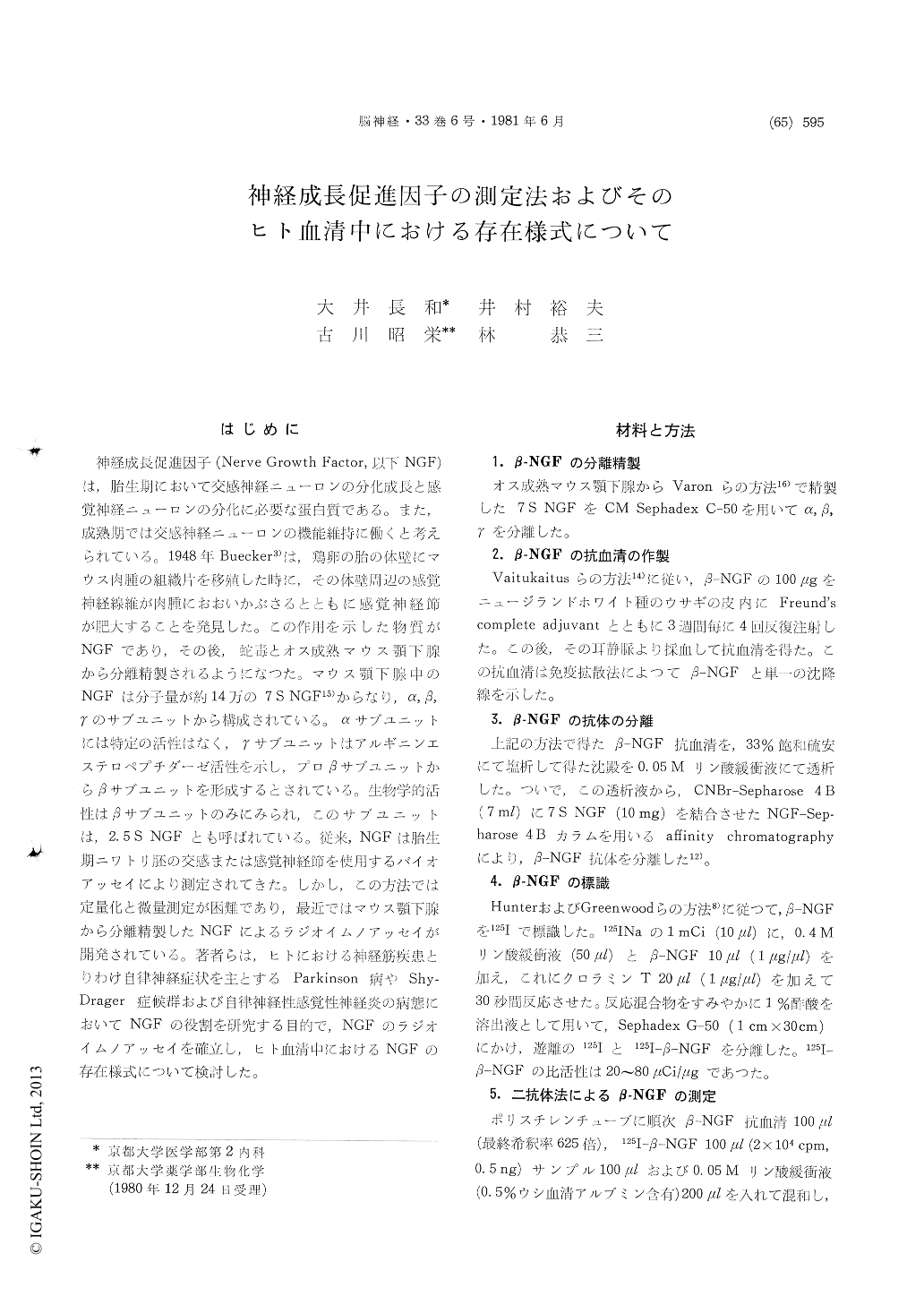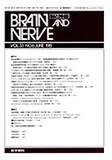Japanese
English
- 有料閲覧
- Abstract 文献概要
- 1ページ目 Look Inside
はじめに
神経成長促進因子(Nerve Growth Factor,以下NGF)は,胎生期において交感神経ニューロンの分化成長と感覚神経ニューロンの分化に必要な蛋白質である。また,成熟期では交感神経ニューロンの機能維持に働くと考えられている。1948年Buecker3)は,鶏卵の胎の体壁にマウス肉腫の組織片を移殖した時に,その体壁周辺の感覚神経線維が肉腫におおいかぶさるとともに感覚神経節が肥大することを発見した。この作用を示した物質がNGFであり,その後,蛇毒とオス成熟マウス顎下腺から分離精製されるようになつた。マウス顎下腺中のNGFは分子量が約14万の7SNGF15)からなり,α,β,γのサブユニットから構成されている。αサブユニットには特定の活性はなく,γサブユニットはアルギニンエステロペプチダーゼ活性を示し,プロβサブユニットからβサブユニットを形成するとされている。生物学的活性はβサブユニットのみにみられ,このサブユニットは,2.5SNGFとも呼ばれている。従来,NGFは胎生期ニワトリ胚の交感または感覚神経節を使用するバイオアッセイにより測定されてきた。しかし,この方法では定量化と微量測定が困難であり,最近ではマウス顎下腺から分離精製したNGFによるラジオイムノアッセイが開発されている。著者らは,ヒトにおける神経筋疾患とりわけ自律神経症状を主とするParkinson病やShy—Drager症候群および自律神経性感覚性神経炎の病態においてNGFの役割を研究する目的で,NGFのラジオイムノアッセイを確立し,ヒト血清中におけるNGFの存在様式について検討した。
Nerve growth factor (NGF) is a protein that supports the growth and maintenance of sympathic neurons and the development of some sensory neurons during a brief period of the development. The highest concentration of NGF occurs in the submaxillary gland of the adult male mouse, from which it has been isolated, characterized and se-quenced. There is the strong evidence that NGF is present in other mammals as well. Mouse 7S NGF is known to consist of α-, β- and γ-subunits, of which only β-unit has the biological activity of nerve fiber outgrowth. It is reported that there is a factor which the NGF-like immunoreactivity (NGF-LI) in human serum which has the biological and immunological activities as those of mouse NGF.
The level of NGF-LI in human serum is so low that the level is difficult to detect by the bioassay using chick embryo dorsal ganglia. Recently, bacteriophage complement fixation methods, assay employing clonal pheochromocytoma cell line, radio-receptor assay and radioimmunoassay have devel-oped. Using antiserum against mouse NGF, we first set up radioimmunoassay for NGF using double antibody immunoprecipitation method. By this method, however, the level of NGF-LI in human serum was found to be 100-500ng/ml, a concentra-tion of NGF that would be expected to give a strong response in the bioassay. But human sera showed no NGF activity by the tissue culture method. Hence, if 125I-β-NGF binds to the serum components, its binding to the antibody is pre-vented and results would be an overstimation of NGF in the serum. In fact, 125I-β-NGF added to human serum was eluted at the elution position of macroglobulin on the gel chromatography. To minimize the effect of this binding protein, wetried the use of solid-phase radioimmunoassay sys-tem in the detection of NGF-LI level in human sera. The advantage of this method is that serum is not mixed with 125I-β-NGF, so that the inter-ference of the binding protein is excluded. In order to clarify the state of NGF-LI in human sera, each fraction obtained by the gel filtration of human serum on a Sephadex G-150 colum at various pH conditions was examined for the biological and immunological activities. The results suggest that there are at least two NGF-LI in the serum, one being free and another existing as a complex form associated with serum component (s) of high mole-cular weight. It is possible that macroglobulin would play as a regulating factor of NGF-LI metabolism.

Copyright © 1981, Igaku-Shoin Ltd. All rights reserved.


